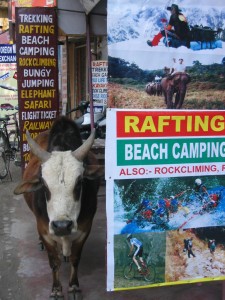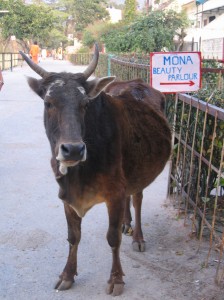Ghee’s role in Yoga
November 6, 2008
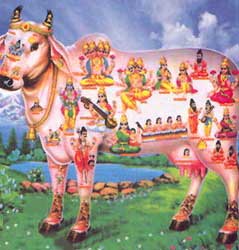 Both Yoga and Ayurveda have roots going back over 5,000 years. But how relevant is their wisdom in the 21st Century? Ayurvedic and Yogic texts contain countless references to Ghee but very little has been written from a modern perspective. Ghee is being blamed for India’s health problems such as rising levels of obesity, cardiovascular disease and diabetes. It is rapidly being replaced with ‘healthier’ vegetable fats. In 2007, I wrote my dissertation on whether ghee’s position at the heart if Ayurveda and Yoga is justified.
Both Yoga and Ayurveda have roots going back over 5,000 years. But how relevant is their wisdom in the 21st Century? Ayurvedic and Yogic texts contain countless references to Ghee but very little has been written from a modern perspective. Ghee is being blamed for India’s health problems such as rising levels of obesity, cardiovascular disease and diabetes. It is rapidly being replaced with ‘healthier’ vegetable fats. In 2007, I wrote my dissertation on whether ghee’s position at the heart if Ayurveda and Yoga is justified.
This article summarise Ghee’s role in Yoga. Future articles will look at:
- Ghee’s role in the Ayurvedic diet (Winter Newsletter)
- Ghee’s role in Ayurvedic treatment of disease (Spring Newsletter)
- 21st Century scientific assessment of Ghee (Summer Newsletter)
First, what is ghee, or clarified butter?
Ghee is made from freshly churned butter after both the water and milk solids have been removed through heating.
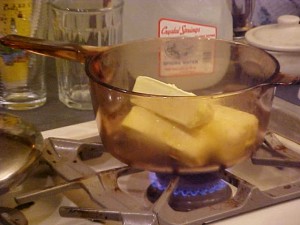 To make ghee, place one or two bars of unsalted butter in a saucepan until it boils; then lower the heat. When the white foam of milk solids which will accumulate on the top begins to collapse and thicken, start skimming it off. Do not disturb the bottom of the pan, as some of these solids will also sink and can be left in the pot until after the ghee is poured off. As the butter continues to boil, watch the oily portion to see when it becomes clear, and watch the sediment on the bottom to see when it turns a golden brown. Be careful this does not burn! When all the water is evaporated, the bubbling sound will stop. When only the clear oil and the golden sediment remain, the ghee is ready. Remove from the heat, and let it sit for a moment. Pour the ghee off into an earthenware, glass or metal container (not plastic- it will melt!) Ghee doesn’t need to be in fridge but do keep out moisture- so don’t use a wet spoon! Keeps for 3 months.
To make ghee, place one or two bars of unsalted butter in a saucepan until it boils; then lower the heat. When the white foam of milk solids which will accumulate on the top begins to collapse and thicken, start skimming it off. Do not disturb the bottom of the pan, as some of these solids will also sink and can be left in the pot until after the ghee is poured off. As the butter continues to boil, watch the oily portion to see when it becomes clear, and watch the sediment on the bottom to see when it turns a golden brown. Be careful this does not burn! When all the water is evaporated, the bubbling sound will stop. When only the clear oil and the golden sediment remain, the ghee is ready. Remove from the heat, and let it sit for a moment. Pour the ghee off into an earthenware, glass or metal container (not plastic- it will melt!) Ghee doesn’t need to be in fridge but do keep out moisture- so don’t use a wet spoon! Keeps for 3 months.
From an Ayurvedic perspective, ghee is viewed as more potent than milk due to it being transformed by fire. It is also much more stable, and can be kept for long periods without going bad (up to 3 months, unrefrigerated for cooking purposes). Ghee is sweet in taste, cold in nature and sweet in its after-taste, as is oily, soft, and heavy. Due to varying predominance of the 5 Ayurvedic elements in different types of milk, ghee from different species have different properties. For example, Ghee made from Elephant and Buffalo milk is the heaviest, with that from goat and camel milk being driest! Ayurveda recommends ghee from cow’s milk as as best for general food and medicinal purposes.
Ghee – a brief history
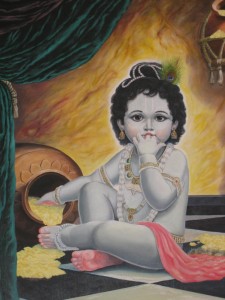 The Vedas, Ayurvedic Samhitas and Yoga texts contain frequent references to ghee in many guises for maintaining health, promoting healing and ceremonial uses. One who had ample stocks of ghee was said to possess liquid gold, and Krishna was said to be very found of ghee as a young child, to fuel his intellectual powers and spiritual development. The Sage Bhavaprakasha describes two specific process, in that ghee can be prepared from milk ‘stale by one day’ as well as ‘butter from milk’. The oldest written record of the human race is the Rig Veda, by which time milk had already become an important food, with cows being considered as sacred. It is likely humans have been making ghee since milk became part of the diet with ghee being made in many countries where milk is a staple part of the diet (Asia, the Middle-East and Africa).
The Vedas, Ayurvedic Samhitas and Yoga texts contain frequent references to ghee in many guises for maintaining health, promoting healing and ceremonial uses. One who had ample stocks of ghee was said to possess liquid gold, and Krishna was said to be very found of ghee as a young child, to fuel his intellectual powers and spiritual development. The Sage Bhavaprakasha describes two specific process, in that ghee can be prepared from milk ‘stale by one day’ as well as ‘butter from milk’. The oldest written record of the human race is the Rig Veda, by which time milk had already become an important food, with cows being considered as sacred. It is likely humans have been making ghee since milk became part of the diet with ghee being made in many countries where milk is a staple part of the diet (Asia, the Middle-East and Africa).
Ghee’s role in the ancient Yogic texts, the Vedas
”Brahman is the oblation; Brahman is the ghee; by Brahman is the oblation poured into the fire of Brahman.” (Baghavad Gita:4/24)
Ghee’s importance is reflected by many references in the ancient Vedas (the oldest scriptures known) to its use in the yogic diet, cleansing practices, and rituals (such as prayers, mantras, and offerings). To fully appreciate Ghee’s importance the role of food in general must be outlined. In Yogic philosophy, food is recognised as the great entity of life as its is responsible for the growth of the body. It is hence called Brahman (God), and rice mixed with ghee and ‘soma’ juice is described as the diet of God. Food is hence considered as sacred itself with most of the ancient Upanishad texts beginning with the diet of India’s ancient civilised society.
The sacred cow
 Beyond food being equal to God, the Vedas state the cow is the most sacred animal. The cow represents the giving nature of life in that they ”yield butter and milk inexhaustible for thee set on the highest summit.” (Rig Veda, 9/ 2.7) The Yogi view is that if you honour the ever giving cow, you also honour all creatures. As a result, cow worship is seen as of the highest form of worship in Yoga, and indeed other cultures. From a more practical point of view, cows were and are still vital for gaining adequate nutrition. Milk is a unique food, containing the best the mother can offer, even at the expense of her own health. The importance of cows in traditional Indian culture cannot be overemphasised.
Beyond food being equal to God, the Vedas state the cow is the most sacred animal. The cow represents the giving nature of life in that they ”yield butter and milk inexhaustible for thee set on the highest summit.” (Rig Veda, 9/ 2.7) The Yogi view is that if you honour the ever giving cow, you also honour all creatures. As a result, cow worship is seen as of the highest form of worship in Yoga, and indeed other cultures. From a more practical point of view, cows were and are still vital for gaining adequate nutrition. Milk is a unique food, containing the best the mother can offer, even at the expense of her own health. The importance of cows in traditional Indian culture cannot be overemphasised.
So where does ghee fit in?
“Ghee is the essence of milk. From this essence we cannot obtain anything else. This essence is like the most confidential verse of all in the Bhagavad-Gita. But you must remember and consider that to turn milk into ghee is no ordinary endeavour and also to acquire the understanding and realization necessary to comprehend the essence of all 700 verses of the illustrious Bhagavad-Gita is also no ordinary endeavour” (Srila Bhaktivedanta Narayana Maharaja).
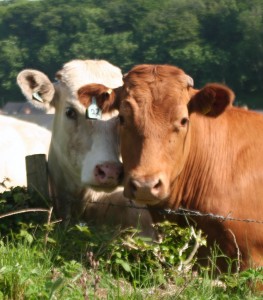 Ghee is perceived as the essence of milk, with the cow’s first milk for the calf being comparable to the general teachings from Lord Krishnain the Gita. The remaining milk, cream and butter are analogous to the next three levels of teaching, each more subtle than the last. Ghee represents the most subtle teachings of all.
Ghee is perceived as the essence of milk, with the cow’s first milk for the calf being comparable to the general teachings from Lord Krishnain the Gita. The remaining milk, cream and butter are analogous to the next three levels of teaching, each more subtle than the last. Ghee represents the most subtle teachings of all.
Interestingly, Buddha also uses this analogy: ”From a cow comes milk; from milk, curd; from curd, butter; from butter, ghee; from ghee, the skimmings of ghee, and that is reckoned the best; even so, monks, among these four individuals the person who is engaged in promoting his own good and also the good of another is the foremost, the chief, the principal, the best and the supreme.” (Chavalata Sutta/ Anguttara Nikaya IV.95)
Use of Ghee in Yogic practices
 In light of nothing being considered more sacred than the cow and ghee being its essence, it is clear why ghee plays such a central role in Yogic practices. For example, during Diwali, ghee lamps are used to honour the gods. Many ceremonies involve pouring ghee, along with other offerings, into a fire which transforms them into higher vibrations. Yogis are advised to gaze at a ghee-lamp as astral entities can give Darshan (vision) through its flames. Just as cows nourish humans, ghee is believed to nourish inhabitants of more celestial realms. Without ghee, it is not possible to satisfy Lord Krishna and “it is solely and exclusively from the ghee of cows that the sacred rituals prescribed and authorised in the Vedas are empowered and able to be performed.” (Jagannath Das).
In light of nothing being considered more sacred than the cow and ghee being its essence, it is clear why ghee plays such a central role in Yogic practices. For example, during Diwali, ghee lamps are used to honour the gods. Many ceremonies involve pouring ghee, along with other offerings, into a fire which transforms them into higher vibrations. Yogis are advised to gaze at a ghee-lamp as astral entities can give Darshan (vision) through its flames. Just as cows nourish humans, ghee is believed to nourish inhabitants of more celestial realms. Without ghee, it is not possible to satisfy Lord Krishna and “it is solely and exclusively from the ghee of cows that the sacred rituals prescribed and authorised in the Vedas are empowered and able to be performed.” (Jagannath Das).
In these examples, beyond actually allowing lamps to burn or increasing the intensity of the fire, ghee symbolises the burning away of illness, ignorance and mental afflictions. Through such purification, the Yogi can see truth that everything is made up of God: ”Brahman is the oblation; Brahman is the ghee; by Brahman is the oblation poured into the fire of Brahman” (BG/ 4/24). Just as ghee exists in milk but cannot be perceived, Brahman is present everywhere.
Ghee is an ideal food for the yogi
“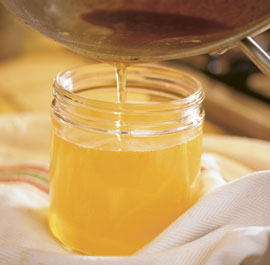 He who begins the practise of yoga without controlling the diet suffers from many diseases and does not make progress in yoga”. (Gheranda Samhita 5/16)
He who begins the practise of yoga without controlling the diet suffers from many diseases and does not make progress in yoga”. (Gheranda Samhita 5/16)
It should not come as a surprise that ghee is very important for the yoga practitioner. Ghee seen as the ideal sattvic (pure) food, purifying the mind, awakening knowledge and developing intuition. Ancient Yogis used ghee to helps move towards Yoga’s aim of stilling the mind, via the promotion of both physical and mental purification. Ancient texts give dietary guidelines for the Yogi, with ghee coming first in lists of ‘do’s’. It is advised ”sweet and nourishing food should be mixed with ghee and milk, nourishing all dhatus [tissues] and be pleasing and suitable.” (Hatha Yoga Pradipika, C1/62-63). Ghee is contrasted with prohibited foods which are too bitter, sour, pungent, salty, dry, and burning. Foods such as garlic, chillies and onions are seen as too irritating and stimulating, interfering with the subtle effects of Yoga. Yogis who have been practising for some time become especially sensitive to such foods.
In contrast, milk and ghee ”take care of the nervous system and prepare it to withstand the heightened activity when it takes place” (Desai, 1990). Even the preparation of ghee is considered helpful in inducing a pure mind as by maintaining a clean appearance and calm mind during its preparation it becomes ”one of the most healing food sadhanas when performed with grace.” (Tiwari 1995: p182). Ghee’s ability to increase the physical element of fire is also used by Yogis on breaking a fast. For example, ghee with a light soup is very helpful in rekindling the digestive fire (agni) (Charaka Samhita, Chikitsa Sthana 15/ 206).
Ghee and spiritual development
“The subtle part of churned curds rises up and becomes butter. The subtle part of food when eaten rises up and becomes mind”. (Chandogya Upanishad 6/6/1).
Both milk and ghee are of such importance to the yogi that Swami Sivananda goes so far to discuss the problem of sadhus (holy men) not being able to afford them in his book ‘Yoga in Daily Life’. To explain this importance the special relationship between food and the mind must be appreciated. Just as butter is made from the subtle part of milk ”food when eaten becomes threefold, its gross form is shit, its middle flesh, its subtlest mind” (Chandogyopanshad 6/5/1). Both Yoga and Ayurveda believe that the mind and body can affect each other so it is impossible to look at ghee’s effects on the body and mind in separation. Beyond basic nutritional needs, food also forms the mind. Yoga and Ayurveda emphasise a pure vegetarian diet to encourage the development of spiritual awareness.
However, Yoga goes beyond Ayurveda in considerations of spiritual development. Take the analogy of the body as a chariot, the soul as the owner of the chariot, the intellect as the driver, the mind as the reins of the horses, the five senses as five horses and, finally, the world as the arena for the chariot (Katha Upanishad, 3/ 4-10). Ayurveda’s focus is on using the reins wisely so the chariot stays on the track, whereas Yoga’s aim is to take the owner to the destination. It is not possible to experience inner joy, a steady mind and sense control with an impure mind.
Ghee’s ability to purify the mind is also known in Ayurveda, where tonics for the mind contain ghee. Indeed, the Ayurvedic sage Sushruta describes divine remedies (divya rasayana) which lead to total mental transformation and supernormal powers usually only achieved by advanced yogis (Bhavamisra: Bhavaprakasha, Chi 8: 1-6). Unfortunately, such these formulations are no longer known so we must continue with our yoga! However, ghee taken daily in the diet will help practising Yogis in strengthening the mind and purifying intellect (buddhi). The aim of yoga is to reach ”the state when the buddhi is in its ultimate perfection and purity…. and final liberation takes place” (Dasgupta, 1997).
How does ghee promote mental purification?
”With ghee let those that purify our ghee purify us” (Yajurveda 1/2/1).
Yogic practises such as pranayama, hatha yoga (asanas), mudras (hand gestures), bandhas (energy locks), meditation, brahmacharya (abstinence), and ahimsa (non-violence) all lead to the creation of physical heat in the body. This is more than physical heat as it is a pranic, mental, or spiritual heat, psychic in nature. It is also known as ‘tapas’(to burn, create heat or to produce energy). Just as ghee is offered in fire ceremonies due to its effect of increasing the fire, Yogis use ghee to increase purifying heat in both body and mind. Just as a burnt seed becomes incapable of reproducing, when the mind is totally pure it becomes incapable of producing more reincarnations and liberation takes place. However, too much heat can be harmful, and ghee is recommended in pranayama to prevent the mental heat causing physical burning sensations. Practitioners of pranayama are advised to take milk and ghee daily by Swami Sivananda in his ‘Science of Pranayama’.
And physical purification?
To purify his mind, the Yogi must also look to purifying his body. Yoga has 6 detoxification practises of dhauti, basti, neti, trataka, nauli and kapalbhati. Dhauti involves evacuating large quantities of water through the bowels, swallowing a long strip of cloth, or regurgitating the contents of the stomach. Basti involves sucking air or water into the large intestine and expelling it. Neti involves cleaning the nasal passages with warm salt water, a soft thread, ghee or milk. Nauli involves isolation and churning of abdominal muscles, and kappalabhati is sucking air or water in through the nose. Such practises clean the body’s tracts allowing prana to flow during asanas and pranayama. However, both ghee and milk are important in restoring balance. For example, both help maintain the body’s mucous lining which would otherwise be washed away. They also neutralise acidity and heat in the stomach, created by these practises. There are many similarities between these Yogic cleansing techniques and Ayurvedic detoxification (panchakarma). Both clean body and hence the mind. However, only the Yogi cleansing techniques have a specific spiritual effect with neti said to bestow clairvoyance alongside balancing kapha dosha. (Gheranda Samhita 1/33).
Summary:
 Ghee’s importance in yoga is reflected by extensive classical references in the traditional yogic diet, cleansing practices, and sacred rituals. Ghee is itself sacred, being the essence of the sacred cow, and in its act of increasing heat. Many rituals described in the Vedas would be inauthentic without it.
Ghee’s importance in yoga is reflected by extensive classical references in the traditional yogic diet, cleansing practices, and sacred rituals. Ghee is itself sacred, being the essence of the sacred cow, and in its act of increasing heat. Many rituals described in the Vedas would be inauthentic without it.
Ghee is ideal for the yogi on many levels, as a food, mental tonic, and to aid pranayama and Yogic detoxification techniques. It acts on all three bodies perceived by Yoga Philosophy: the physical body, made up of food, through nourishment, increasing digstive fire (agni) and protecting; the astral body, made up of the vital, mental and intellectual sheaves, through purifying intellect; and through its effect of increasing psychic heat, it also acts subtly on the causal body made up of the bliss sheath. However, ghee and milk should only be consumed in moderation as both have the potential to aggravate kapha. Even the most pure foods are dulling (tamasic) if taken in excess.
The Ayurvedic Sages were fully aware of ghee’s auspicious nature. They made full use of its many attributes to serve health and healing- expanded in the next article on Ayurvedic uses of Ghee in diet (January 2009)
Where to learn more on yogic uses of ghee:
- Verma, V (2001): Patanjali and Ayurvedic Yoga- a comparison of classical yoga with Ayurveda, the practise of Ayurvedic yoga in our daily lives for healing, maintaining health and harmony; Motilal Banardidass Publishers PVT Ltd
- Yogeshwar, MG (1994): The Origin of Yogic Cleansings. Ancient Science of Life, Vol XIV, Nos 1&2, July- October 1994, Pages 117-121
- Desai, BP (1989): Place of Nutrition in Yoga. Ancient Science of Life, Vol IX, No 3, January 1990, Pages 147-153.
- Dasgupta, S. (1997): A History of Indian Philosophy. Motilal Banarsidass, Vol 1, 7
- Sharma R.K, Dash B (1997): Charaka Samhita, Chowkhamba Sanskrit Series
- Sharma, P.V. (1999): Sushruta Samhita. Varanasi, India, Chaukhambha Visvabharati
- Tiwari, M (1995): Ayurveda- a Life of Balance. Healing Arts Press
- Bhavaprakasha, Purva Khanda, Prathama bhaga (Part 1), Ghrt Varga (C6)
- Vasu, Rai Bahadur Srisa Chandra Vasu (2004): The Siva Samhita. Munshiram Manoharlal Publishers Pvt. Ltd
- Jacobs, A (2003): The Principal Upanishads: The Essential Philosophical Foundation of Hinduism. Watkins Publishing.
- Mallinson, J (2004): The Gheranda Samhita: Original Sanskrit and English Translation.
- Yoga Vidya Saraswati, Swami Satyananda: Four Chapters on Freedom, Commentary on the Yoga Sutras of Patanjali; Yoga Publications Trust, India (1976)
- Sivananda (1995): The Bhagavad Gita: Text and commentary. The Divine Life Society, India.Sivananda: Spiritual Lessons; Science of Pranayama; Divine Life Society Publications (viewed online)
